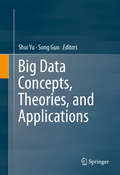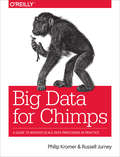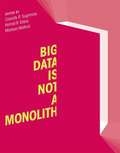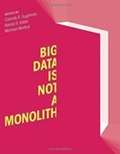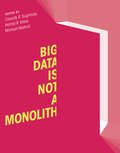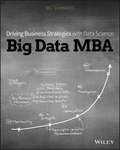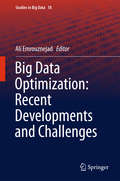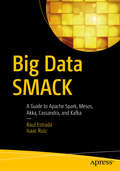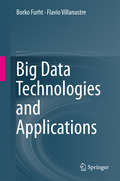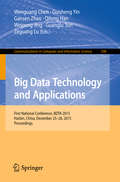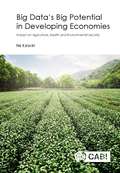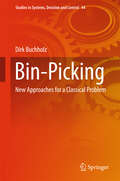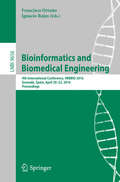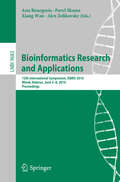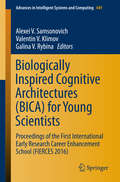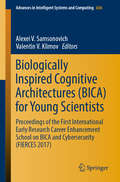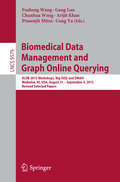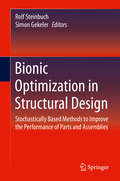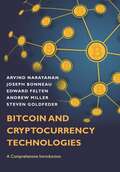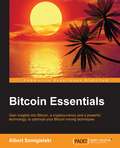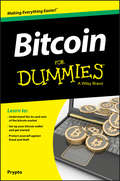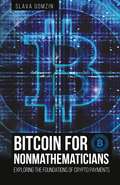- Table View
- List View
Big Data Concepts, Theories, and Applications
by Shui Yu Song GuoThisbook covers three major parts of Big Data: concepts, theories andapplications. Written by world-renowned leaders in Big Data, this book exploresthe problems, possible solutions and directions for Big Data in research andpractice. It also focuses on high level concepts such as definitionsof Big Data from different angles; surveys in research and applications; andexisting tools, mechanisms, and systems in practice. Each chapter is independentfrom the other chapters, allowing users to read any chapter directly. After examining the practical sideof Big Data, this book presents theoretical perspectives. The theoreticalresearch ranges from Big Data representation, modeling and topology todistribution and dimension reducing. Chapters also investigate the manydisciplines that involve Big Data, such as statistics, data mining, machinelearning, networking, algorithms, security and differential geometry. The lastsection of this book introduces Big Data applications from differentcommunities, such as business, engineering and science. Big Data Concepts, Theories and Applications is designed as a reference for researchersand advanced level students in computer science, electrical engineering andmathematics. Practitioners who focus on information systems, big data, datamining, business analysis and other related fields will also find thismaterial valuable.
Big Data for Chimps: A Guide to Massive-Scale Data Processing in Practice
by Russell Jurney Philip Flip KromerFinding patterns in massive event streams can be difficult, but learning how to find them doesn't have to be. This unique hands-on guide shows you how to solve this and many other problems in large-scale data processing with simple, fun, and elegant tools that leverage Apache Hadoop. You'll gain a practical, actionable view of big data by working with real data and real problems.Perfect for beginners, this book's approach will also appeal to experienced practitioners who want to brush up on their skills. Part I explains how Hadoop and MapReduce work, while Part II covers many analytic patterns you can use to process any data. As you work through several exercises, you'll also learn how to use Apache Pig to process data.Learn the necessary mechanics of working with Hadoop, including how data and computation move around the clusterDive into map/reduce mechanics and build your first map/reduce job in PythonUnderstand how to run chains of map/reduce jobs in the form of Pig scriptsUse a real-world dataset--baseball performance statistics--throughout the bookWork with examples of several analytic patterns, and learn when and where you might use them
Big Data Is Not a Monolith
by Cassidy R. Sugimoto Hamid R. Ekbia Michael MattioliBig data is ubiquitous but heterogeneous. Big data can be used to tally clicks and traffic on web pages, find patterns in stock trades, track consumer preferences, identify linguistic correlations in large corpuses of texts. This book examines big data not as an undifferentiated whole but contextually, investigating the varied challenges posed by big data for health, science, law, commerce, and politics. Taken together, the chapters reveal a complex set of problems, practices, and policies.The advent of big data methodologies has challenged the theory-driven approach to scientific knowledge in favor of a data-driven one. Social media platforms and self-tracking tools change the way we see ourselves and others. The collection of data by corporations and government threatens privacy while promoting transparency. Meanwhile, politicians, policy makers, and ethicists are ill-prepared to deal with big data's ramifications. The contributors look at big data's effect on individuals as it exerts social control through monitoring, mining, and manipulation; big data and society, examining both its empowering and its constraining effects; big data and science, considering issues of data governance, provenance, reuse, and trust; and big data and organizations, discussing data responsibility, "data harm," and decision making.ContributorsRyan Abbott, Cristina Alaimo, Kent R. Anderson, Mark Andrejevic, Diane E. Bailey, Mike Bailey, Mark Burdon, Fred H. Cate, Jorge L. Contreras, Simon DeDeo, Hamid R. Ekbia, Allison Goodwell, Jannis Kallinikos, Inna Kouper, M. Lynne Markus, Michael Mattioli, Paul Ohm, Scott Peppet, Beth Plale, Jason Portenoy, Julie Rennecker, Katie Shilton, Dan Sholler, Cassidy R. Sugimoto, Isuru Suriarachchi, Jevin D. West
Big Data Is Not a Monolith
by Cassidy R. Sugimoto Hamid R. Ekbia Michael MattioliBig data is ubiquitous but heterogeneous. Big data can be used to tally clicks and traffic on web pages, find patterns in stock trades, track consumer preferences, identify linguistic correlations in large corpuses of texts. This book examines big data not as an undifferentiated whole but contextually, investigating the varied challenges posed by big data for health, science, law, commerce, and politics. Taken together, the chapters reveal a complex set of problems, practices, and policies.The advent of big data methodologies has challenged the theory-driven approach to scientific knowledge in favor of a data-driven one. Social media platforms and self-tracking tools change the way we see ourselves and others. The collection of data by corporations and government threatens privacy while promoting transparency. Meanwhile, politicians, policy makers, and ethicists are ill-prepared to deal with big data's ramifications. The contributors look at big data's effect on individuals as it exerts social control through monitoring, mining, and manipulation; big data and society, examining both its empowering and its constraining effects; big data and science, considering issues of data governance, provenance, reuse, and trust; and big data and organizations, discussing data responsibility, "data harm," and decision making.ContributorsRyan Abbott, Cristina Alaimo, Kent R. Anderson, Mark Andrejevic, Diane E. Bailey, Mike Bailey, Mark Burdon, Fred H. Cate, Jorge L. Contreras, Simon DeDeo, Hamid R. Ekbia, Allison Goodwell, Jannis Kallinikos, Inna Kouper, M. Lynne Markus, Michael Mattioli, Paul Ohm, Scott Peppet, Beth Plale, Jason Portenoy, Julie Rennecker, Katie Shilton, Dan Sholler, Cassidy R. Sugimoto, Isuru Suriarachchi, Jevin D. West
Big Data Is Not a Monolith (Information Policy)
by Cassidy R. Sugimoto Hamid R. Ekbia Michael MattioliPerspectives on the varied challenges posed by big data for health, science, law, commerce, and politics.Big data is ubiquitous but heterogeneous. Big data can be used to tally clicks and traffic on web pages, find patterns in stock trades, track consumer preferences, identify linguistic correlations in large corpuses of texts. This book examines big data not as an undifferentiated whole but contextually, investigating the varied challenges posed by big data for health, science, law, commerce, and politics. Taken together, the chapters reveal a complex set of problems, practices, and policies.The advent of big data methodologies has challenged the theory-driven approach to scientific knowledge in favor of a data-driven one. Social media platforms and self-tracking tools change the way we see ourselves and others. The collection of data by corporations and government threatens privacy while promoting transparency. Meanwhile, politicians, policy makers, and ethicists are ill-prepared to deal with big data's ramifications. The contributors look at big data's effect on individuals as it exerts social control through monitoring, mining, and manipulation; big data and society, examining both its empowering and its constraining effects; big data and science, considering issues of data governance, provenance, reuse, and trust; and big data and organizations, discussing data responsibility, “data harm,” and decision making.ContributorsRyan Abbott, Cristina Alaimo, Kent R. Anderson, Mark Andrejevic, Diane E. Bailey, Mike Bailey, Mark Burdon, Fred H. Cate, Jorge L. Contreras, Simon DeDeo, Hamid R. Ekbia, Allison Goodwell, Jannis Kallinikos, Inna Kouper, M. Lynne Markus, Michael Mattioli, Paul Ohm, Scott Peppet, Beth Plale, Jason Portenoy, Julie Rennecker, Katie Shilton, Dan Sholler, Cassidy R. Sugimoto, Isuru Suriarachchi, Jevin D. West
Big Data MBA
by Bill SchmarzoIntegrate big data into business to drive competitive advantage and sustainable success Big Data MBA brings insight and expertise to leveraging big data in business so you can harness the power of analytics and gain a true business advantage. Based on a practical framework with supporting methodology and hands-on exercises, this book helps identify where and how big data can help you transform your business. You'll learn how to exploit new sources of customer, product, and operational data, coupled with advanced analytics and data science, to optimize key processes, uncover monetization opportunities, and create new sources of competitive differentiation. The discussion includes guidelines for operationalizing analytics, optimal organizational structure, and using analytic insights throughout your organization's user experience to customers and front-end employees alike. You'll learn to "think like a data scientist" as you build upon the decisions your business is trying to make, the hypotheses you need to test, and the predictions you need to produce. Business stakeholders no longer need to relinquish control of data and analytics to IT. In fact, they must champion the organization's data collection and analysis efforts. This book is a primer on the business approach to analytics, providing the practical understanding you need to convert data into opportunity. Understand where and how to leverage big data Integrate analytics into everyday operations Structure your organization to drive analytic insights Optimize processes, uncover opportunities, and stand out from the rest Help business stakeholders to "think like a data scientist" Understand appropriate business application of different analytic techniques If you want data to transform your business, you need to know how to put it to use. Big Data MBA shows you how to implement big data and analytics to make better decisions.
Big Data Optimization: Recent Developments and Challenges (Studies in Big Data #18)
by Ali EmrouznejadThemain objective of this book is to provide the necessary background to work withbig data by introducing some novel optimization algorithms and codes capable ofworking in the big data setting as well as introducing some applications in bigdata optimization for both academics and practitioners interested, and tobenefit society, industry, academia, and government. Presenting applications ina variety of industries, this book will be useful for the researchers aiming toanalyses large scale data. Several optimization algorithms for big dataincluding convergent parallel algorithms, limited memory bundle algorithm,diagonal bundle method, convergent parallel algorithms, network analytics, andmany more have been explored in this book.
Big Data SMACK: A Guide to Apache Spark, Mesos, Akka, Cassandra, and Kafka
by Raul Estrada Isaac RuizLearn how to integrate full-stack open source big data architecture and to choose the correct technology--Scala/Spark, Mesos, Akka, Cassandra, and Kafka--in every layer. Big data architecture is becoming a requirement for many different enterprises. So far, however, the focus has largely been on collecting, aggregating, and crunching large data sets in a timely manner. In many cases now, organizations need more than one paradigm to perform efficient analyses. Big Data SMACK explains each of the full-stack technologies and, more importantly, how to best integrate them. It provides detailed coverage of the practical benefits of these technologies and incorporates real-world examples in every situation. This book focuses on the problems and scenarios solved by the architecture, as well as the solutions provided by every technology. It covers the six main concepts of big data architecture and how integrate, replace, and reinforce every layer: The language: Scala The engine: Spark (SQL, MLib, Streaming, GraphX) The container: Mesos, Docker The view: Akka The storage: Cassandra The message broker: Kafka What You Will Learn: Make big data architecture without using complex Greek letter architectures Build a cheap but effective cluster infrastructure Make queries, reports, and graphs that business demands Manage and exploit unstructured and No-SQL data sources Use tools to monitor the performance of your architecture Integrate all technologies and decide which ones replace and which ones reinforce Who This Book Is For: Developers, data architects, and data scientists looking to integrate the most successful big data open stack architecture and to choose the correct technology in every layer
Big Data Technologies and Applications
by Borko Furht Flavio VillanustreThe objective of this book is to introduce the basic concepts of big data computing and then to describe the total solution of big data problems using HPCC, an open-source computing platform. The book comprises 15 chapters broken into three parts. The first part, Big Data Technologies, includes introductions to big data concepts and techniques; big data analytics; and visualization and learning techniques. The second part, LexisNexis Risk Solution to Big Data, focuses on specific technologies and techniques developed at LexisNexis to solve critical problems that use big data analytics. It covers the open source High Performance Computing Cluster (HPCC Systems®) platform and its architecture, as well as parallel data languages ECL and KEL, developed to effectively solve big data problems. The third part, Big Data Applications, describes various data intensive applications solved on HPCC Systems. It includes applications such as cyber security, social network analytics including fraud, Ebola spread modeling using big data analytics, unsupervised learning, and image classification. The book is intended for a wide variety of people including researchers, scientists, programmers, engineers, designers, developers, educators, and students. This book can also be beneficial for business managers, entrepreneurs, and investors.
Big Data Technology and Applications: First National Conference, BDTA 2015, Harbin, China, December 25-26, 2015. Proceedings (Communications in Computer and Information Science #590)
by Qilong Han Weipeng Jing Guanglu Sun Zeguang Lu Wenguang Chen Guisheng Yin Gansen ZhaoThis bookconstitutes the refereed proceedings of the First National Conference on BigData Technology and Applications, BDTA 2015, held in Harbin, China, in December2015. The 26revised papers presented were carefully reviewed and selected from numeroussubmissions. The papers address issues such as the storage technology of Big Data;analysis of Big Data and data mining; visualization of Big Data; the parallelcomputing framework under Big Data; the architecture and basic theory of BigData; collection and preprocessing of Big Data; innovative applications in someareas, such as internet of things and cloud computing.
Big data's big potential in developing economies: impact on agriculture, health and environmental security
by Nir KshetriBig data involves the use of sophisticated analytics to make decisions based on large-scale data inputs. It is set to transform agriculture, environmental protection and healthcare in developing countries. This book critically evaluates the developing big data industry and market in these countries and gives an overview of the determinants, performances and impacts. The book provides a detailed analysis of technology creation, technology infrastructures and human skills to utilize big data in these countries. It discusses novel applications and business models involving big data to overcome healthcare barriers. The book also offers an analysis of big data's potential to improve environmental monitoring and protection. It posits that big data is likely to have far-reaching and profound impacts on the agricultural sector. A key question addressed is also how gains in agricultural productivity associated with big data will benefit smallholder farmers relative to global multinationals in that sector. It also probes big data's roles in the creation of markets that can improve the welfare of smallholder farmers. The book gives special consideration to big data-led transformation of the financial industry and discusses how the transformation can increase small-holder farmers' access to finance by changing the way lenders assess creditworthiness of potential borrowers. It also takes a look at data privacy and security issues facing smallholder farmers and reviews differences in such issues in industrialized and developing countries. The key ideas, concepts and theories presented are explored, illustrated and contrasted through in-depth case studies of developing world-based big data companies and deployment and utilization big data in agriculture, environmental protection and healthcare.
Bildgebende Verfahren in der Medizin: Von der Technik zur medizinischen Anwendung
by Olaf DösselDieses erfolgreiche Standardwerk beschreibt s#65533;mtliche bildgebenden Verfahren von der R#65533;ntgentechnik #65533;ber den Ultraschall bis zu den Methoden der Tomographie. Es werden sowohl die technischen Grundlagen als auch die medizinischen Anwendungen erl#65533;utert. Das Lehrbuch zeichnet sich aus durch eine verst#65533;ndliche Darstellung, zahlreiche Illustrationen der grundlegenden Prinzipien sowie durch Bilder von den verschiedenen Modalit#65533;ten und von den Ger#65533;ten. Die 2. Auflage wurde aktualisiert und enth#65533;lt neue Trends und Entwicklungen, insbesondere beim R#65533;ntgen und Ultraschall. Kapitel #65533;ber Magnetic Particle Imaging (MPI) wurden hinzugef#65533;gt.
Billionaire on the Loose: Billionaires and Bridesmaids 5 (Billionaires and Bridesmaids #5)
by Jessica ClareEnter the illustrious world of Jessica Clare's billionaires and bridesmaids. Fans of J.S. Scott, Louise Bay and Melody Anne will addicted to this sizzling, coveted New York Times bestseller. You met the six bachelors of the Billionaire Boys Club... Now it's time to pair up some filthy-rich billionaires with lucky ladies in waiting and enjoy the spoils... Taylor is a genius when it comes to computers, but understanding the opposite sex is beyond her. Because she always fumbles her flirtations, she needs help in finding her Prince Charming. So when her friend, Gretchen, sets her up as a tour guide for a new guy in town, she says yes despite her misgivings.She just doesn't expect Mr. Charming to actually be royalty...A faction in his country wants him to be king, but Loch has no intention of taking the crown. To keep from being named as the next successor, he hatches a scheme to marry a totally unacceptable American woman. Quirky Taylor seems like the perfect person for the job, until Loch realizes he likes more about her than her ability to keep him off the throne.When Loch's secret schemes come out, his chance of happiness with Taylor are blown - unless he can find a way to get the nerdy object of his affection to believe she's truly the queen of his heart... Includes a teaser for The Billionaire's Favourite Mistake!After more dazzling romance? Look out for the rest of the Billionaire and Bridesmaids series starting with The Billionaire And The Virgin or take a spin with the steamy Billionaire Boys Club starting with Stranded With A Billionaire.
Bin-Picking: New Approaches for a Classical Problem (Studies in Systems, Decision and Control #44)
by Dirk BuchholzThis bookis devoted to one of the most famous examples of automation handling tasks -the "bin-picking" problem. To pick up objects, scrambled in a box is aneasy task for humans, but its automation is very complex. In this book threedifferent approaches to solve the bin-picking problem are described, showinghow modern sensors can be used for efficient bin-picking as well as how classicsensor concepts can be applied for novel bin-picking techniques. 3D pointclouds are firstly used as basis, employing the known Random Sample Matchingalgorithm paired with a very efficient depth map based collision avoidancemechanism resulting in a very robust bin-picking approach. Reducing thecomplexity of the sensor data, all computations are then done on depth maps. This allows the use of 2D image analysis techniques to fulfill the tasks andresults in real time data analysis. Combined with force/torque and accelerationsensors, a near time optimal bin-picking system emerges. Lastly, surface normalmaps are employed as a basis for pose estimation. In contrast to knownapproaches, the normal maps are not used for 3D data computation but directlyfor the object localization problem, enabling the application of a new class ofsensors for bin-picking.
Bioinformatics and Biomedical Engineering: 4th International Conference, IWBBIO 2016, Granada, Spain, April 20-22, 2016, Proceedings (Lecture Notes in Computer Science #9656)
by Ignacio Rojas Francisco OrtuñoThis book constitutes the refereed proceedings of the 4th International Conference on Bioinformatics and Biomedical Engineering, IWBBIO 2016, held in Granada, Spain, in April 2016. The 69 papers presented were carefully reviewed and selected from 286 submissions. The scope of the conference spans the following areas: bioinformatics for healthcare and diseases; biomedical image analysis; biomedical signal analysis; computational systems for modeling biological processes; eHealth; tools for next generation sequencing data analysis; assistive technology for people with neuromotor disorders; fundamentals of biological dynamics and maximization of the information extraction from the experiments in the biological systems; high performance computing in bioinformatics, computational biology and computational chemistry; human behavior monitoring, analysis and understanding; pattern recognition and machine learning in the -omics sciences; and resources for bioinformatics.
Bioinformatics and Computational Biology in Drug Discovery and Development
by William T. LogingComputational biology drives discovery through its use of high-throughput informatics approaches. This book provides a road map of the current drug development process and how computational biology approaches play a critical role across the entire drug discovery pipeline. Through the use of previously unpublished, real-life case studies the impact of a range of computational approaches are discussed at various phases of the pipeline. Additionally, a focus section provides innovative visualisation approaches, from both the drug discovery process as well as from other fields that utilise large datasets, recognising the increasing use of such technology. Serving the needs of early career and more experienced scientists, this up-to-date reference provides an essential introduction to the process and background of drug discovery, highlighting how computational researchers can contribute to that pipeline.
Bioinformatics Research and Applications: 12th International Symposium, ISBRA 2016, Minsk, Belarus, June 5-8, 2016, Proceedings (Lecture Notes in Computer Science #9683)
by Anu Bourgeois Pavel Skums Xiang Wan Alex ZelikovskyThis book constitutes the proceedings of the 12th International Symposium on Bioinformatics Research and Applications, ISBRA 2016, held in Minsk, Belarus, in June 2016. The 25 papers presented in this volume were carefully reviewed and selected from 77 submissions. They were organized in topical sections named: next generation sequencing data analysis; protein-protein interactions and networks; protein and RNA structure; phylogenetics; sequence analysis; and statistical methods.
Biologically Inspired Cognitive Architectures: Proceedings of the First International Early Research Career Enhancement School (FIERCES 2016) (Advances in Intelligent Systems and Computing #449)
by Alexei V. Samsonovich Valentin V. Klimov Galina V. RybinaThis book presents cutting-edge research focused on current challenges towards the realization of Biologically Inspired intelligent agents, or Cognitive Architectures (BICA). The chapters are written by both world-recognized experts (including Antonio Chella, Olivier Georgeon, Oliver Kutz, Antonio Lieto, David Vernon, Paul Verschure, and others) and young researchers. Together, they constitute a good mixture of new findings with tutorial-based reviews and position papers, all presented at the First International Early Research Career Enhancement School on Biologically Inspired Cognitive Architectures (FIERCES on BICA 2016), held April 21-24 in Moscow, Russia. Most works included here cross boundaries between disciplines: from neuroscience to social science, from cognitive science to robotics, and from bioengineering to artificial intelligence. A special emphasis is given to novel solutions to urgent problems that have been resisting traditional approaches for decades. Intended for providing readers with an update on biologically inspired approaches towards the computational replication of all the essential aspects of the human mind (the BICA Challenge), this book is expected to foster lively discussions on the topic and stimulate cross-disciplinary, cross-generation and cross-cultural collaboration.
Biologically Inspired Cognitive Architectures: Proceedings of the First International Early Research Career Enhancement School on BICA and Cybersecurity (FIERCES 2017) (Advances in Intelligent Systems and Computing #636)
by Valentin V. Klimov Alexei V. SamsonovichThis book presents cutting-edge research focused on current challenges towards the realization of Biologically Inspired intelligent agents, or Cognitive Architectures (BICA). The chapters are written by both world-recognized experts (including Antonio Chella, Olivier Georgeon, Oliver Kutz, Antonio Lieto, David Vernon, Paul Verschure, and others) and young researchers. Together, they constitute a good mixture of new findings with tutorial-based reviews and position papers, all presented at the First International Early Research Career Enhancement School on Biologically Inspired Cognitive Architectures (FIERCES on BICA 2016), held April 21-24 in Moscow, Russia. Most works included here cross boundaries between disciplines: from neuroscience to social science, from cognitive science to robotics, and from bioengineering to artificial intelligence. A special emphasis is given to novel solutions to urgent problems that have been resisting traditional approaches for decades. Intended for providing readers with an update on biologically inspired approaches towards the computational replication of all the essential aspects of the human mind (the BICA Challenge), this book is expected to foster lively discussions on the topic and stimulate cross-disciplinary, cross-generation and cross-cultural collaboration.
Biomedical Data Management and Graph Online Querying: VLDB 2015 Workshops, Big-O(Q) and DMAH, Waikoloa, HI, USA, August 31 – September 4, 2015, Revised Selected Papers (Lecture Notes in Computer Science #9579)
by Fusheng Wang Gang Luo Chunhua Weng Arijit Khan Prasenjit Mitra Cong YuThis book constitutes the refereed proceedings of the two International Workshops on Big-Graphs Online Querying, Big-O(Q) 2015, and Data Management and Analytics for Medicine and Healthcare, DMAH 2015, held at Waikoloa, Hawaii, USA on August 31 and September 4, 2015, in conjunction with the 41st International Conference on Very Large Data Bases, VLDB 2015. The 9 revised full papers presented together with 5 invited papers and 1 extended abstract were carefully reviewed and selected from 22 initial submissions. The papers are organized in topical sections on information retrieval and data analytics for electronic medical records; data management and visualization of medical data; biomedical data sharing and integration; medical imaging analytics; and big-graphs online querying.
Bionic Optimization in Structural Design: Stochastically Based Methods to Improve the Performance of Parts and Assemblies
by Rolf Steinbuch Simon GekelerThe book provides suggestions on how to start using bionic optimization methods, including pseudo-code examples of each of the important approaches and outlines of how to improve them. The most efficient methods for accelerating the studies are discussed. These include the selection of size and generations of a study's parameters, modification of these driving parameters, switching to gradient methods when approaching local maxima, and the use of parallel working hardware. Bionic Optimization means finding the best solution to a problem using methods found in nature. As Evolutionary Strategies and Particle Swarm Optimization seem to be the most important methods for structural optimization, we primarily focus on them. Other methods such as neural nets or ant colonies are more suited to control or process studies, so their basic ideas are outlined in order to motivate readers to start using them. A set of sample applications shows how Bionic Optimization works in practice. From academic studies on simple frames made of rods to earthquake-resistant buildings, readers follow the lessons learned, difficulties encountered and effective strategies for overcoming them. For the problem of tuned mass dampers, which play an important role in dynamic control, changing the goal and restrictions paves the way for Multi-Objective-Optimization. As most structural designers today use commercial software such as FE-Codes or CAE systems with integrated simulation modules, ways of integrating Bionic Optimization into these software packages are outlined and examples of typical systems and typical optimization approaches are presented. The closing section focuses on an overview and outlook on reliable and robust as well as on Multi-Objective-Optimization, including discussions of current and upcoming research topics in the field concerning a unified theory for handling stochastic design processes.
Bitcoin and Cryptocurrency Technologies: A Comprehensive Introduction
by Andrew Miller Edward Felten Arvind Narayanan Joseph Bonneau Steven Goldfeder<p><i>Bitcoin and Cryptocurrency Technologies</i> provides a comprehensive introduction to the revolutionary yet often misunderstood new technologies of digital currency. Whether you are a student, software developer, tech entrepreneur, or researcher in computer science, this authoritative and self-contained book tells you everything you need to know about the new global money for the Internet age. <p>How do Bitcoin and its block chain actually work? How secure are your bitcoins? How anonymous are their users? Can cryptocurrencies be regulated? These are some of the many questions this book answers. It begins by tracing the history and development of Bitcoin and cryptocurrencies, and then gives the conceptual and practical foundations you need to engineer secure software that interacts with the Bitcoin network as well as to integrate ideas from Bitcoin into your own projects. Topics include decentralization, mining, the politics of Bitcoin, altcoins and the cryptocurrency ecosystem, the future of Bitcoin, and more. <p> <li>An essential introduction to the new technologies of digital currency <li>Covers the history and mechanics of Bitcoin and the block chain, security, decentralization, anonymity, politics and regulation, altcoins, and much more <li>Features an accompanying website that includes instructional videos for each chapter, homework problems, programming assignments, and lecture slides <li>Also suitable for use with the authors' Coursera online course <li>Electronic solutions manual (available only to professors)</li> </p>
Bitcoin Essentials
by Albert Szmigielski<p>Blockchain is being billed as the technology of the future. Bitcoin is the first application of that technology. Mining is what makes it all possible. Exploring mining from a practical perspective will help you make informed decisions about your mining setup. Understanding what the future may hold for blockchains, and therefore for mining, will help you position yourself to take advantage of the impending changes. <p>This practical guide starts with an introduction to Bitcoin wallets, as well as mining hardware and software. You will move on to learn about different mining techniques using the CPU, GPU, FPGA, and ultimately the ASIC as an example. After this, you will gain an insight into solo mining and pool mining, and see the differences between the two. The book will then walk you through large-scale mining and the challenges faced during such operations. Finally, you will take a look into the future to see a world where blockchain-based applications are commonplace and mining is ubiquitous.</p>
Bitcoin For Dummies
by Consumer Dummies Prypto<p><i>Bitcoin For Dummies</i> is the fast, easy way to start trading crypto currency, with clear explanations and expert advice for breaking into this exciting new market. Understanding the mechanisms and risk behind Bitcoin can be a challenge, but this book breaks it down into easy-to-understand language to give you a solid grasp of just where your money is going. You'll learn the details of Bitcoin trading, how to set up your Bitcoin wallet, and everything you need to get started right away. An in-depth discussion on security shows you how to protect yourself against some of the riskier aspects of this open-source platform, helping you reduce your risks in the market and use Bitcoin safely and effectively. <p>Bitcoin uses peer-to-peer technology to operate with no central authority or banks, with transaction management and issuing of Bitcoins carried out collectively by the network. Bitcoin allows easy mobile payments, fast international payments, low- or no-fee transactions, multi-signature capabilities, and more, but the nuances of the market can be difficult to grasp. This informative guide lays it all out in plain English, so you can strengthen your understanding and get started now. <p> <li>Understand the ins and outs of the Bitcoin market <li>Learn how to set up your Bitcoin wallet <li>Protect yourself against fraud and theft <li>Get started trading this exciting new currency</li> <p> <p>The Bitcoin market is huge, growing quickly, and packed with potential. There's also some risk, so you need to go in fully informed and take steps to manage your risk wisely. Bitcoin For Dummies is the clear, quick, easy-to-follow guide to getting started with Bitcoin.</p>
Bitcoin for Nonmathematicians: Exploring the Foundations of Crypto Payments
by Slava GomzinIt's thoughtless to start using something you don't trust. It's difficult to start trusting something you don't understand. Bitcoin for Nonmathematicians contains answers to the following questions: how bitcoin is different from other payment systems, and why we can trust cryptocurrencies. The book compares bitcoin with its predecessors and competitors, and demonstrates the benefits of cryptocurrency over any other existing methods of payments. Bitcoin for Nonmathematicians starts from overview of the evolution of payment systems from gold and paper money to payment cards to cryptocurrencies, and ends up with explaining the fundamentals of security and privacy of crypto payments by explaining the details of cryptography behind bitcoin in layman's terms.
